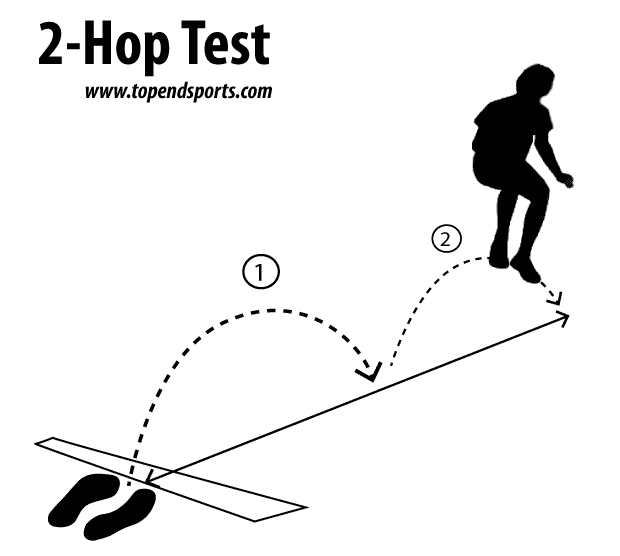This is a test of leg power and coordination in which you have to perform two consecutive horizontal jumps. The 2-Hop Jump is one of the tests of the SPARQ rating system for hockey, and the SPARQ protocol details are listed here. There is also a similar 3-hop test and 5-hop test.
test purpose: to measure the horizontal and vertical power of the legs with a component of balance and coordination, testing the maximum distance of two consecutive double-leg hops.
equipment required: tape measure to measure distance jumped, flat non-slip surface.
pre-test: Explain the test procedures to the subject. Perform screening of health risks and obtain informed consent. Prepare forms and record basic information such as age, height, body weight, gender, test conditions. The starting take off line should be clearly marked. See more details of pre-test procedures.
test layout: Stretch out approximately 20 feet of rope or tape measure to mark the hopping direction and to aid recording the jump distance.

procedure: The athlete starts by standing behind the starting line with feet shoulder width apart and toes to the line. Starting in a crouched position, when ready they leap forward off both feet, performing two consecutive broad jumps with no pause, using a forward as well as a vertical jump style that allows them to gain maximum distance. Upon landing the second broad jump, the athlete should remain standing with feet stationary to permit accurate measurement. Athletes are able to use their arms to assist the explosive movement and for balance.
scoring: The best distance of two trials is recorded. The measurement is taken from the take-off line to the nearest point of contact on the landing of the second jump (back of the heels). The trial is disallowed if the athlete starts with their toes over the take-off line, steps into either hop instead of performing a 2-footed hop, pauses at least a full second upon landing the 1st hop, fails to land the 1st hop cleanly or performs a stutter step prior to the 2nd take-off, or fails to land the 2nd hop in such a way that allows clear marking of the landing spot.
advantages: this test is simple and quick to perform, requiring minimal equipment.
disadvantages: there is some skill component in this test. Coordinating the arms to assist in propelling the body forward, and effectively using the forward momentum of each jump can greatly improve performance.
comments: Falling or stepping backward after the landing will result in measurement to that point of contact rather than where the feet first touched. Some participants will try to use a step at take-off, which is not allowed.
The Test in Action
- The 2-Hop Jump is one of the tests of the SPARQ rating system for ice hockey.
Similar Tests
- Standing long jump test — jump off two feet into a sand pit.
- 3-hop jump test — perform three consecutive horizontal jumps off both feet
- Penta Jump (5-Hop Test) — perform five consecutive horizontal jumps off both feet.
- Hop and Stop Test — a functional movement test which evaluates an individual's ability to hop and then come to a complete stop.
Related Pages
- About ice-hockey SPARQ rating
- See the list of anaerobic tests for other fitness tests of leg power.
- SPARQ fitness rating system


 Current Events
Current Events